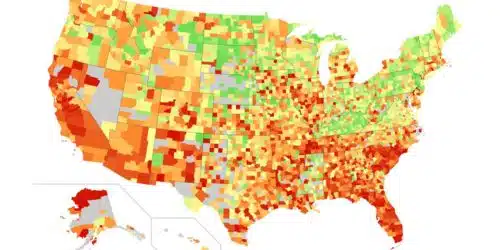Denver, Colorado’s dynamic capital city, has long been noted for its gorgeous scenery, flourishing arts scene, and welcoming people. However, Denver, like any major city, has its share of criminal worries. We go into the topic of the “Denver Crime Rate” in this detailed blog post to shed light on the realities, trends, and causes at play. We hope to offer you a well-rounded picture of Denver’s crime landscape by examining statistical data, assessing critical factors, and investigating crime reduction measures.
Denver Crime Rate
Denver, Colorado’s lively city, is known for its breathtaking natural surroundings, flourishing arts scene, and rich cultural legacy. However, Denver, like any other major city, faces issues, including concerns about crime rates. Let us look at the Denver Crime Rate to shed light on the city’s safety patterns, examine significant statistics, and investigate measures to keep residents and visitors safe.
Understanding Crime Rate in Denver
Denver has a diversified population and a thriving metropolitan atmosphere. It is critical to study existing data and explore numerous elements that contribute to criminal activity to acquire a full picture of the city’s crime rate. We can get a better image of Denver’s crime landscape by looking at crime rate trends, demographics, and socioeconomic characteristics.
The number of reported offenses per 1,000 residents is commonly used to calculate the crime rate in Denver. This rate provides a standardized indicator that may be used to compare cities and jurisdictions. Analyzing crime rates allows policymakers and law enforcement authorities to identify areas of concern, effectively allocate resources, and develop focused crime-fighting initiatives.
Historical Overview of Denver Crime Rate
To understand the current situation of the crime rate in Denver, past trends must be examined. We can identify patterns, and significant changes, and understand the impact of various initiatives undertaken to address crime in the city by analyzing crime data over several years.
The crime rate in Denver has fluctuated throughout the last decade. Between 2010 and 2015, the city saw a gradual decrease in crime, with notable decreases in property crimes. However, there was a minor increase in specific violent crimes during this period, which drew the attention of law enforcement and community leaders.
An In-depth Analysis of Denver Crime Rate Statistics
To acquire a more nuanced picture of the crime rate in Denver, let’s look at the many types of crime and how prevalent they are in the city. This analysis will shed light on areas where improvements are needed as well as highlight successes in reducing crime in specific categories.
#1. Violent Crimes
Homicide, robbery, assault, and sexual assault are examples of violent crimes. Denver’s violent crime rates have fluctuated in recent years. It is critical to investigate these crimes thoroughly to detect patterns, develop targeted solutions, and protect the safety of citizens.
Homicide rates in Denver have fluctuated over the years, increasing and decreasing. While any loss of life is unfortunate, it is heartening to see that there has been a deliberate effort to solve this issue. To effectively prevent and solve homicides, law enforcement agencies have focused on proactive policing, improved investigative techniques, and community outreach.
Robbery and assault are two other major types of violent crimes in Denver. Numerous variables, including prevailing economic conditions and demographic changes, have affected these rates in the city. In recent years, efforts to improve community policing, boost public awareness, and offer resources for crime prevention have contributed to a decrease in robbery and assault rates.
Sexual assault is a deeply troubling crime that necessitates comprehensive prevention and support strategies. To effectively address sexual assault, Denver has prioritized the development of victim support services, educational programs, and collaboration with advocacy groups. While challenges remain, the city’s commitment to making the environment safer for all is clear.
#2. Property Crimes
Property crimes include burglary, theft, motor vehicle theft, and arson. Also, Property crime rates in Denver have been on the decline in recent years. This decrease can be linked to reasons such as increasing community engagement, the use of modern surveillance technologies, and aggressive law enforcement initiatives to locate and apprehend perpetrators.
Burglary rates in Denver have reduced dramatically as a result of enhanced security measures such as home security systems, neighborhood watch programs, and targeted police patrols. Furthermore, community education efforts emphasizing the necessity of securing property and reporting suspicious activity have been critical in avoiding burglaries.
Theft has also decreased in Denver, including both petty and major theft. Increased law enforcement presence in high-theft regions, crime prevention tactics, and public education about protecting personal belongings have all contributed to this beneficial trend. Furthermore, collaborations between law enforcement and businesses have been crucial in lowering theft rates.
Motor vehicle theft, although a continuing threat in many cities, has observed a decreased trajectory in Denver. The deployment of modern anti-theft technologies, public awareness programs, and the establishment of specialist teams within law enforcement agencies have played a key role in fighting motor vehicle theft. It is vital to be cautious and continue applying preventive measures to prolong this favorable trend.
Arson, while less prevalent than other property crimes, poses considerable threats to both property and personal safety. Denver has concentrated on fire safety education, greater enforcement of fire rules, and collaboration with fire departments to prevent arson incidences. Public awareness programs have been essential in educating locals about fire prevention and reporting suspicious activities.
Factors Influencing Crime Rate in Denver
The crime rate in Denver is influenced by a multitude of factors, including social, economic, demographic, and environmental elements. Understanding these elements is vital for designing successful measures to prevent and address crime in the city. Here are some important aspects that contribute to the crime rate in Denver:
#1. Socioeconomic Factors
Economic factors have a big effect on crime rates. Poverty, wealth inequality, unemployment, and a lack of access to quality education and job prospects can all contribute to higher crime rates. High levels of crime are more prevalent in areas with concentrated poverty and low economic resources.
#2. Drug and Gang Activity
Drug-related crimes, including drug trafficking, drug possession, and drug-related violence, can have a considerable impact on crime rates. The presence of gangs and the illegal drug trade often leads to greater violence and other criminal activity.
#3. Demographic Factors
Population demography can influence crime rates. Factors such as population density, age distribution, and cultural dynamics play a part in shaping crime patterns. Neighborhoods with a higher population density and a higher concentration of young individuals may be more prone to certain sorts of crimes.
Communities with strong social linkages, active community groups, and positive relationships between people and law enforcement tend to have lower crime rates. Community engagement, neighborhood watch programs, and measures that create social cohesiveness can contribute to crime prevention efforts.
#5. Law Enforcement Strategies and Resources
The effectiveness of law enforcement strategies and the distribution of resources impact crime rates. Adequate personnel levels, training programs, technological improvements, and community-oriented policing strategies can all contribute to reducing crime and increasing overall city safety.
#6. Education and Public Awareness
Crime rates can be reduced by providing educational opportunities and awareness programs focusing on crime prevention, personal safety, and reporting suspicious activity. Individuals and communities can be empowered to make educated decisions and take proactive efforts to reduce crime by promoting education and offering resources.
#7. Urban Environment and Neighborhood Conditions
Crime rates can be influenced by the physical environment and neighborhood conditions, such as the availability of inexpensive housing, access to social services, the existence of abandoned buildings, and the overall care of public places. Neglected or poorly maintained places may be magnets for criminal activity and contribute to a sense of insecurity.
#8. Substance Abuse and Mental Health Issues
Substance abuse and untreated mental health issues can be factors in criminal behavior. Addressing these underlying issues through therapy, rehabilitation programs, and mental health services can aid in lowering crime rates.
Community Engagement and Crime Prevention Initiatives
Community involvement and crime prevention activities are critical components in combating crime and improving public safety. These projects involve law enforcement agencies, community organizations, residents, and other stakeholders working together to create a shared responsibility for crime prevention. Here are some examples of good community participation and crime reduction projects in Denver:
#1. Community Policing
Community policing stresses the development of relationships and collaborations between law enforcement officers and individuals in the community. It entails proactive participation, problem-solving, and collaborative attempts to address the underlying causes of crime. Community policing initiatives can include regular meetings between police and residents, neighborhood watch programs, community patrols, and joint community-police projects.
#2. Neighborhood Watch Programs
Neighborhood watch programs encourage citizens to take an active role in crime prevention and reporting. These programs encourage neighbors to keep an eye out for one another, report suspicious activity, and collaborate to make their communities safer. Neighborhood watch programs frequently include regular meetings, training sessions, and resident communication networks.
#3. Community Crime Prevention Education
It is critical to educate the community on crime prevention techniques, personal safety, and the need to report crimes. Residents can benefit from workshops, seminars, and public awareness campaigns that teach people how to protect themselves and their property, spot indicators of criminal activity, and report instances to law enforcement authorities.
#4. Youth Engagement Programs
Engaging young people in good activities and offering opportunities for personal development can help reduce teenage criminality. After-school activities, mentoring programs, sports leagues, and arts projects, for example, can give alternatives to delinquency and keep young people engaged in prosocial activities.
#5. Faith-Based Initiatives
Faith-based organizations can make a significant contribution to community participation and crime reduction. They frequently have extensive community ties and can provide resources, support, and guidance to individuals and families. Collaboration with faith-based organizations can entail organizing community activities, offering counseling services, and encouraging conflict resolution and mediation.
#6. Collaborations in Business
Partnerships between law enforcement and local businesses can help with crime prevention efforts. Businesses can take part in crime prevention training, install security measures, and collaborate with law enforcement to share information and address crime concerns in their communities.
#7. Problem-Solving Policing
The goal of problem-oriented policing is to identify and solve the root causes of crime in specific locations or neighborhoods. This technique entails studying crime data, conducting neighborhood polls, and collaborating to find focused solutions to reoccurring concerns. It promotes long-term solutions and encourages community members to participate actively.
#8. Restorative Justice Programs
Restorative justice programs seek to repair the damage done by crime by incorporating offenders, victims, and the community in the resolution process. These programs emphasize accountability, rehabilitation, and relationship restoration. Restorative justice programs can help reduce recidivism and foster communal healing.
Collaboration between Law Enforcement and Technology
Technology has become a useful instrument in crime prevention and law enforcement activities in the digital age. Denver has embraced technological innovation in order to increase public safety and crime-fighting capacities.
#1. Video Surveillance Systems
Strategic placement of video surveillance cameras in public places is effective in deterring criminal activity and assisting law enforcement in identifying and apprehending offenders. Denver has installed large video surveillance systems at strategic sites, which have aided in crime prevention and investigation.
#2. Data Analysis and Predictive Policing
Data analysis and predictive policing tactics have transformed law enforcement strategies. Law enforcement agencies in Denver can deploy resources more efficiently and proactively address potential crime hotspots by analyzing crime data, identifying patterns, and utilizing predictive algorithms.
Collaborative Efforts for a Safer Denver
To ensure a city’s safety, many parties, including law enforcement agencies, community organizations, local government authorities, and people, must work together. There have been commendable initiatives and collaborations in Denver aimed at making the city a safer place for all.
#1. Crime Prevention Partnerships
Denver’s law enforcement agencies work actively with neighborhood organizations, businesses, and educational institutions to create crime prevention initiatives that are tailored to individual needs. These collaborations have achieved major achievements in reducing crime rates through building relationships, pooling resources, and engaging in cooperative efforts.
#2. Education and Awareness Campaigns
Raising public awareness and education on crime prevention techniques, personal safety, and reporting procedures are critical components of any complete crime reduction strategy. Educational campaigns, workshops, and community forums are held in Denver to provide residents with knowledge and equip them to actively participate in crime prevention efforts.
The Future of Crime Rate in Denver
While Denver has made significant progress in lowering the crime rate and improving public safety, the work is far from finished. In the future, it is critical to maintain the momentum of crime reduction initiatives while also adapting to new challenges.
#1. Embracing Technological Advancements
As technology advances, Denver must remain at the forefront of innovation to combat new forms of crime. Embracing technological advancements such as artificial intelligence, predictive analytics, and cybersecurity measures will be critical in keeping criminals at bay and ensuring the city’s safety.
Addressing the underlying causes of crime entails addressing social and economic disparities within the city. Continued efforts to improve access to education, employment, affordable housing, and social support systems will help Denver become a safer and more equitable city.
Numerous factors, such as socioeconomic circumstances, demographics, and community involvement, have an impact on Denver’s crime rate, which is a complicated issue. The city has made significant strides in reducing crime rates and improving public safety by analyzing crime data, implementing targeted initiatives, and encouraging collaboration between law enforcement and the community.
Moving forward, it is critical to sustain these efforts, capitalize on technological advancements, and address underlying social and economic disparities to create a safer and more secure Denver for all residents and visitors.
Conclusion
In recent years, Denver’s commitment to reducing crime and improving public safety has yielded positive results. The city has made significant progress in reducing crime rates and creating a safer environment through community engagement, collaborative partnerships, and the effective use of technology.
However, the work is ongoing, and continued efforts to address socioeconomic disparities, embrace technological advancements, and promote community involvement will be critical to keeping Denver on track. Denver can thrive as a vibrant and secure city for years to come if it prioritizes safety and crime prevention.
- SEATTLE CRIME RATE IN 2023-2024
- IS DENVER SAFE? All You Need To Know
- WORST NEIGHBORHOODS IN CHICAGO IN 2023
- 25 BEST LUNCH SPOTS IN DENVER In 2023
- SAFEST CITIES IN COLORADO IN 2023






